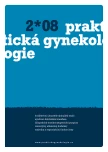Prevention of Rh (D) alloimmunization in Rh (D) negative women
Authors:
M. Lubušký
Authors‘ workplace:
LF UP a FN Olomouc
; Gynekologicko-porodnická klinika
Published in:
Prakt Gyn 2008; 12(2): 100-103
Poznámka redakce: Materiál níže uvedené práce byl opakovaně projednán na výboru Sekce perinatální medicíny ČGPS ČLS JEP, kde nebyl schválen. Nejedná se o doporučený postup odborné společnosti, ale osobní stanovisko autora.
Overview
Key words:
Anti-D Immunoglobulin, alloimmunization, fetomaternal hemorrhage
Sources
1. Martin JA, Hamilton BE, Ventura SJ et al. Births: fi nal data for 2001. Natl Vital Stat Rep 2002; 51 : 1–102.
2. ACOG – American College of Obstetricians and Gynecologists. Prevention of RhD alloimmunization. ACOG practice bulletin no.4. Washington, DC, 1999.
3. Fung KFK, Eason E, Crane J et al. Maternal - Fetal Medicine Committee, Genetics Committee. Prevention of Rh alloimmunization. J Obstet Gynaecol Can 2003; 25 : 765–773.
4. RANZCOG – Royal Australian and New Zealand College of Obstetricians and Gynaecologists. Guidelines for the use of RH D Immunoglobulin (Anti-D) in obstetrics in Australia 2007. www.ranzcog.edu.au/publications/statements/ C-obs6.pdf
5. RCOG – Royal College of Obstetrics and Gynaecology. United Kingdom. Green Top Guidelines 2002. Use of Anti-D immunoglobulin for Rh prophylaxis 2002. www.rcog.org. uk/index.asp?PageID=512
6. Crowther C, Middleton P. Anti-D administration after childbirth for preventing Rhesus alloimmunisation. Cochrane Database Syst Rev 2007; 4 (updated August 2007).
7. Crowther C, Middleton P. Anti-D administration in pregnancy for preventing Rhesus alloimmunisation. Cochrane Database Syst Rev 2007; 4 (updated August 2007).
8. Bowman JM. Controversies in Rh prophylaxis. Who needs Rh immune globulin and when shoud it be given? Am J Obstet Gynecol 1985; 151 : 289–294.
9. Contreras M. The prevention of Rh haemolytic disease of the fetus and newborn – general background. Br J Obstet Gynaecol 1998; 105 : 7–10.
10. Hadley A, Soothill P. Alloimmune disorders of pregnancy: anaemia, thrombocytopenia and neutropenia in the fetus and newborn. Cambridge: Cambridge University Press 2002.
11. Brambati B, Guercilena S, Bonacchi I et al. Feto-maternal transfusion after chorionic villus sampling: clinical implications. Hum Reprod 1986; 1 : 37–40.
12. Augustson BM, Fong EA, Grey DE et al. Postpartum anti-D: can we safely reduce the dose? Med J Aust 2006; 184 : 611–613.
13. Moise KJ Jr. Management of rhesus alloimunization in pregnancy. Obstet Gynecol 2002; 100 : 600–611.
14. Ness PM, Baldwin ML, Niebyl JR. Clinical high-risk designation does not predict excess fetal-maternal haemorrhage. Am J Obstet Gynecol 1987; 156 : 154–158.
15. Sebring E, Polesky H. Fetomaternal hemorrhage: incidence, risk factors, time of occurence and clinical effects. Transfusion 1990; 30 : 344–357.
16. Stedman C, Baudin J, White C et al. Use of the erythrocyte rosette test to screen for excessive fetomaternal hemorrhage in Rh negative women. Am J Obstet Gynecol 1986; 154 : 1363–1369.
17. Feldman N, Skoll A, Sibai B. The incidence of signifi cant fetomaternal haemorrhage in patients undergoing cesarean section. Am J Obstet Gynecol 1990; 163 : 855–858.
18. Chilcott J, Lloyd JM, Wight J et al. A review of the clinical effectiveness and cost effectiveness of routine anti-D prophylaxies for pregnant women who are Rhesus (RhD) negative 2002, National Institute of Clinical Excelence, London.
19. NHMRC – National Health and Medical Research Council. Australia. National Blood Authority. Gudelines on the prophylactic use of Rh D immunoglobulin (anti-D) in obstetrics 2003.
20. RCOG – Royal College of Obstetrics and Gynaecology. United Kingdom. Use of Anti - D immunoglobulin for Rh prophylaxis 2000. www.rcog.org.uk/guidelines/antid.html
21. RCOG – Royal College of Obstetrics and Gynaecology. United Kingdom. NICE – National Institute for Clinical Excellence‘s Technology Appraisal Gudance No 41. Guidance on the use of routine antenatal anti-D prophylaxis for RhD-negative women, May 2002 (Expected date of next issue – June 2008). http: //guidance. nice.org.uk/TA41/guidance/pdf/English www. n i c e . o rg . u k / g u i d a n c e / i n d ex . jsp?action=download&r=true&o=32360
Labels
Paediatric gynaecology Gynaecology and obstetrics Reproduction medicineArticle was published in
Practical Gynecology

2008 Issue 2
Most read in this issue
- Twin-to-twin transfusion syndrome
- The influence of morbid obesity as an independent risk factor of termination of pregnancy by caesarean section
- Prevention of Rh (D) alloimmunization in Rh (D) negative women
- Idiopathic thrombocytopenic purpura in pregnancy
